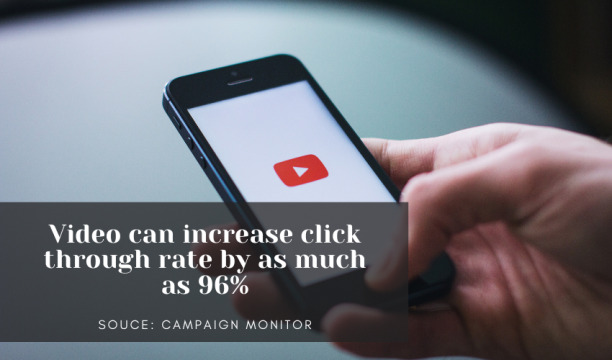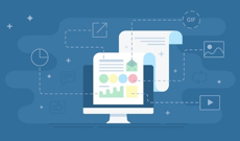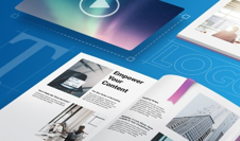The world of marketing has changed a lot in 2020. From enhanced privacy concerns, to big developments in AI, to an increase in work from home jobs; 2020 has been a difficult year to predict.
One thing that hasn’t changed, however, is the popularity of email marketing. Email marketing is an integral part of any sales channel strategy. The potential is huge—for every $1 invested in email marketing, you can expect an average return of $42.
This leads us to the all important question: why does email perform so well? Because everyone uses email. What’s more, it’s convenient. With a simple email businesses can share all the important news, updates, and information weekly or monthly.
However, many businesses aren’t optimizing their email newsletters and unlocking their full potential. Perhaps you’ve been writing and sending email newsletters for so long now that you’ve lost sight of any inspirational ideas to make them stand out. Luckily, a few simple updates are enough to refresh your newsletter template and take your email marketing to the next level.
Make a Good First Impression
First impressions are everything when it comes to email marketing. Okay, maybe not everything but they can make a big difference. Without an effective subject line that captures the reader’s attention, it’s likely that your email won’t even be opened, let alone read.
Subject lines have a huge impact on email open rate. Think about it, when you check your email, which ones do you open? The ones that stand out, right?
If you want to freshen up your email newsletter, try to experiment with subject lines. That way you can measure the results and see which emails get high open rates and which don’t. This will give you a good idea of what your readers are interested in, and what makes them tick.
Effective subject line ideas
Here are some ideas to inspire your next great subject line:
- Mention a video in the subject line. Video can increase not only your open rate by over 5% but also your CTR by as much as 96%.
- Personalize it! Customers want to be treated like human beings, not disembodied email addresses on a subscription list.
- Increase readers’ curiosity with a subject line that encourages them to keep reading to find out more.
- Pose a question to your readers, encouraging them to read on to find the answer.
- Create easily digestible lists. They’re organized, they flow, and they’re easy to read. For instance, “Top 5 Benefits of Printing Less”.
- Additionally, consider leveraging AI writer tools to craft highly effective and engaging copy that resonates with your target audience.
What to avoid
There are some things you should avoid in your newsletter subject lines too. These are guaranteed to be off-putting to readers and come across as insincere. Plus, they’re likely to get picked up by spam filters and sent straight to the junk folder. Try to avoid:
- Using ALL CAPS. Not only does it seem like you’re yelling at the reader, but it’s also unprofessional and reminiscent of those “YOU’VE JUST WON $1 MILLION” spam emails.
- Using sales language. People are inundated with advertisements and sales content daily. If you can offer your customers something else in your newsletter, they’ll likely find more value in it.
- Avoid using exclamation points. Again, this seems insincere, as though you’re excited about something that isn’t really that exciting!!!
- Try not to include “free” in the subject line. It’s likely to get picked up as spam.
Try Something New
If you’ve been sending out standardized email marketing campaigns for the last year, perhaps it’s time to try something new.
Just like fashion trends change every year, so do trends in e-commerce. So you might want to mix up your email newsletter design and surprise your readers. Newsletters that generated great click-through rates (CTRs) last year are not performing so well in 2020, try to change templates every so often to keep things fresh.

There are plenty of ways you can change the design of your newsletter. If you always follow the same structure, why not add or remove different elements and see how these newsletters perform? For instance:
- Go visual. Capture readers’ attention with an eye-catching image, a small line of captivating text, and a call-to-action (CTA).
- 2020 e-commerce trends suggest that customers respond to video. Try sending a video newsletter explaining the latest goings-on, offers, and anything else you want to share with your customers.
- Add infographics or snappy statistics with a link to a piece of informative content.
- Try a different color scheme, font, or other simple design and layout changes.
- Include links to your social media pages to boost engagement on different platforms.
Once you try out some different designs you’ll be able to measure your CTR and see which ones readers responded well to. A/B testing can help you compare your older designs to newer ones, to make sure they’re actively better. Remember: sending out a badly designed newsletter won’t reflect well on your brand, so make sure you keep design at the forefront of your creative process.
Ask Readers What They Want
Sometimes all you have to do is ask.
Just like inventory accounting helps you keep track of stock, implementing a customer feedback program will give you access to data that’ll help you meet your customers’ expectations in the future.
Send out a post-purchase survey asking customers about what they want to get out of their experience with your brand. For instance, pose questions like:
- What would you like to see in the newsletter?
- When and how often do you want to receive it?
- What did you like the most/least about your experience so far?
By engaging your audience with a post-purchase email, you can gain valuable insights into what they expect from their customer experience. This will help you deliver results, boost brand loyalty, and increase sales. By asking them for their opinion, you’re also showing them that you value their input. This encourages brand intimacy and will help you to build lasting relationships with your customers.
Make Sure the Time Is Right
When planning your email newsletter, think about when you’re going to send it. Be sure that you’re hitting the send button at the right time of day and on the right day of the week.
Many industries follow the rule that Tuesdays and Thursdays are the best days of the week to send email newsletters. However, every organization is different. If you find that sending emails on a Monday isn’t generating great results, try sending on a different day and see what happens.
The time of day that you send emails is also a vital engagement determiner. Campaign Monitor found that 53% of emails are opened during the workday between 9 a.m.–5 p.m. Research shows that the top times to send emails during the day are 10am, 8pm, 2pm, and 6am. Try out a few different times and see which ones work for you.
Another important thing to note as you consider when you send your emails, is how often you send them. Just because a customer is subscribed to your email updates doesn’t mean they want to be bombarded with 5 emails per day, or even per week for that matter.
Consider limiting your emails to once a week. This is more than often enough to update your audience on news, offers, and any other information that will be valuable to them. You can also ask customers their preference on sign-up, letting them opt into daily, weekly or monthly roundups. Email automation workflows can help with this, allowing you to schedule your emails for the week or month.
Use Email Automation Workflows
Automation is everywhere—we have automated customer service, automated CRMs, and automated order management software. There are plenty of automation tools that allow businesses to perform better. These tools provide deeper insights into customer experiences, allowing them to create the experience consumers expect with better item data.
It’s more than likely that you’re already using email automation workflows, because honestly, who has the time to send all those emails manually?
In 2019, 66% of email marketers highlighted automation as an important attribute of email solutions. If you’re refreshing your email newsletter, it’s a good idea to take a look at how your email automation tools are performing.
Email automation workflows can help you to streamline all of the processes we’ve mentioned above, including design, personalization, and segmentation.
By automating your email campaigns you can:
- Nurture leads.
- Personalize email content.
- Access more detailed reporting to assess the results of your campaign.
- Improve targeting and segmentation strategies.
- Make life easier for your sales team.
- Reduce the potential for errors.
- Save on costs.
- Save valuable time that you can spend on crucial tasks.
Ensure Your Newsletter Design Is Mobile-Friendly
Did you know that 46% of all email opens are on mobile devices? It’s important to ensure your newsletter design is mobile-friendly.
You don’t want to lose out on subscribers simply because your email layout doesn’t look good on any device apart from a computer or laptop. Make sure your newsletter is optimized to read well on mobile, tablets, and even smart watches to reduce the risk of losing subscribers.

(Photo by Kon Karampelas on Unsplash)
By sprucing up your email newsletters you can re-capture your audience, as well as attract new leads. Focus on providing valuable content, intriguing news in the right tone of voice. Mixing up your design and newsletter content will keep your audience on their toes, opening your emails, and clicking those links.
When done right, email marketing can yield incredible results. So keep it informative, keep it fresh, and keep it real.
Author's bio:
Nick Shaw is the Chief Revenue Officer (CRO) of Brightpearl, a leading provider of inventory, warehouse and order management software. He is responsible for Global Marketing, Sales and Alliances for the leading retail inventory management software provider. Nick has written for sites such as Hubspot and G2. Here is Nick Shaw’s LinkedIn.





